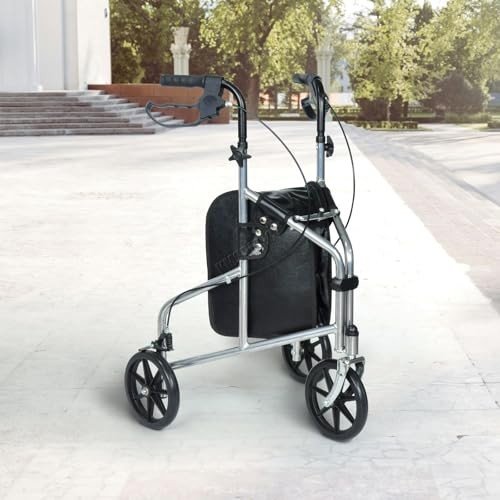senior-walker0011
senior-walker0011
Guide To Rollator With Wheels: The Intermediate Guide To Rollator With Wheels
Understanding Rollators with Wheels: A Comprehensive Guide
Rollators, likewise referred to as wheeled walkers, have ended up being progressively popular among individuals seeking mobility support. These innovative devices provide a mix of assistance, stability, and convenience, making them perfect for seniors and individuals with disabilities. This short article checks out the features, benefits, types, and factors to consider of rollators with wheels, in addition to frequently asked concerns to help you make a notified choice.
What is a Rollator?
A rollator is a mobility device geared up with three or four wheels, hand brakes, and a frame created for stability. Unlike standard walkers, which require users to raise the device to move, rollators slide efficiently, enabling users to stroll naturally while getting assistance. The majority of rollators likewise include a seat for resting, making them particularly advantageous for those who might tire easily.
Secret Features of Rollators
- Wheels: Generally designed with either three or 4 wheels, offering balance and stability while walking.
- Hand Brakes: These brakes allow users to stop the rollator safely while promoting self-confidence throughout use.
- Seat: Many rollators come equipped with a seat for resting, ideal for users who may require to take breaks during walks.
- Basket or Storage Bag: Convenient for carrying personal items, shopping, or essentials during getaways.
- Adjustable Height: Frames are typically adjustable for a custom-made fit, accommodating users of numerous heights.
Benefits of Using a Rollator with Wheels
Rollators offer many benefits for individuals with restricted mobility. Some of the essential benefits consist of:
- Enhanced Mobility: Rollators enable users to maintain independence and mobility, making it much easier to browse indoors and outdoors.
- Enhanced Stability: The presence of wheels and brakes supplies extra support, minimizing the danger of falls.
- Benefit of Use: Users can stroll naturally without needing to raise the gadget, which can ease stress on the arms and back.
- Comfortable Seating: Users can take breaks whenever needed, reducing fatigue and enabling longer getaways.
- Increased Confidence: With much better assistance and stability, users might feel more protected in their motions, leading to greater mobility.
Types of Rollators
When thinking about a rollator, a variety of alternatives are available to deal with varied requirements:
-
Standard Rollators: Typically included four wheels, bigger frames, and a comfortable seat, making them ideal for a lot of users.
-
Compact Rollators: Designed for indoor use or travel, these rollators are lightweight, foldable, and typically include smaller sized frames.
-
Heavy-Duty Rollators: Engineered for users who might require additional support, these rollators normally have a higher weight capability and a larger frame.
-
Three-Wheeled Rollators: More maneuverable than their four-wheeled equivalents, these rollators are perfect for browsing tighter areas.
Considerations Before Purchasing a Rollator
Before purchasing a Rollator with Wheels, there are several factors that should be thought about to ensure the very best fit for private requirements:
- Weight Capacity: Check the weight limit to guarantee it supports the user’s weight properly.
- Frame Size: Ensure that the frame fits the user’s height for optimal convenience and support.
- Wheel Size: Larger wheels are generally better for outdoor use and rough surface, while smaller wheels are more suited for indoor use.
- Storage Options: Consider just how much storage is necessary for mobility aids, shopping, or individual products.
- Mobility: If travel is a top priority, select a foldable and lightweight model for ease of transport.
Upkeep of Rollators
Appropriate upkeep can prolong the life of a rollator and make sure safety during use. Here are some suggestions:
- Regularly Check Brakes: Ensure that hand brakes operate properly and change them as required.
- Check Wheels: Look for wear and tear; replace wheels if they show signs of damage.
- Tighten Up Loose Parts: Regularly inspect for any loose screws or bolts and tighten them to preserve stability.
- Clean the Frame: Wipe down the frame regularly to keep it devoid of dirt and particles.
Table: Comparison of Rollator Types
| Kind of Rollator | Wheel Count | Perfect Use | Weight Capacity | Portability |
|---|---|---|---|---|
| Requirement Rollator | 4 | General mobility | 300 pounds | Moderate |
| Compact Rollator | 4 | Indoor/Travel | 250 lbs | High |
| Heavy-Duty Rollator | 4 | Rigorous use | 400 pounds | Low |
| Three-Wheeled Rollator | 3 | Tight areas | 300 lbs | Moderate |
FAQs About Rollators with Wheels
Q1: How do I select the right rollator for my needs?

A1: Consider factors such as your height, weight, and where you’ll mainly use the rollator (indoor vs. outdoor). A trial at a mobility shop might likewise help you find a comfy fit.
Q2: Are rollators tough to navigate?
A2: Most rollators are created for ease of use, and with practice, users usually discover them simple to maneuver, specifically those with turning wheels.
Q3: What is the average cost of a rollator?
A3: Prices can vary substantially, from roughly ₤ 70 for standard models to over ₤ 300 for high-end or customized designs.
Q4: Can rollators be utilized outdoors?
A4: Yes, numerous rollators are developed for both indoor and outdoor use. However, choosing one with larger wheels can boost stability on unequal terrain.
Q5: How do I maintain my rollator?
A5: Regularly inspect the brakes and wheels for wear, tighten any loose parts, and clean the frame regularly to make sure safety and longevity.
Rollators with wheels are necessary mobility aids that promote independence and security for users. By understanding the features, benefits, and maintenance of rollators, people can make educated choices about their mobility requires. With the right rollator, users can delight in better mobility, self-confidence, and lifestyle.



